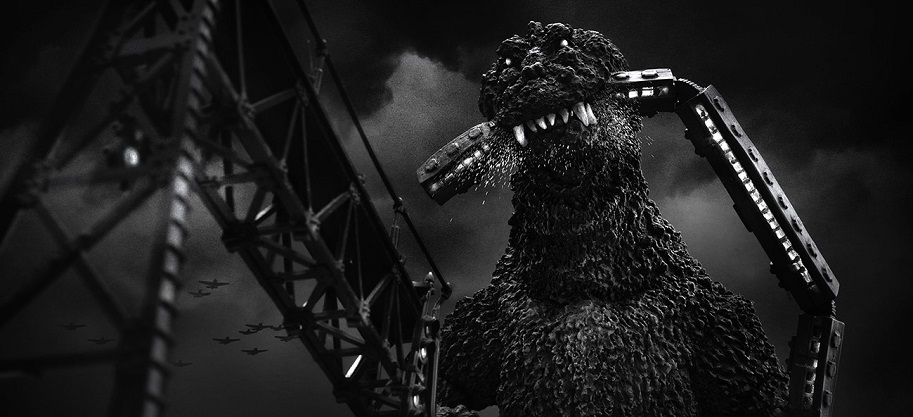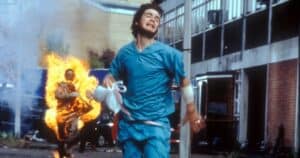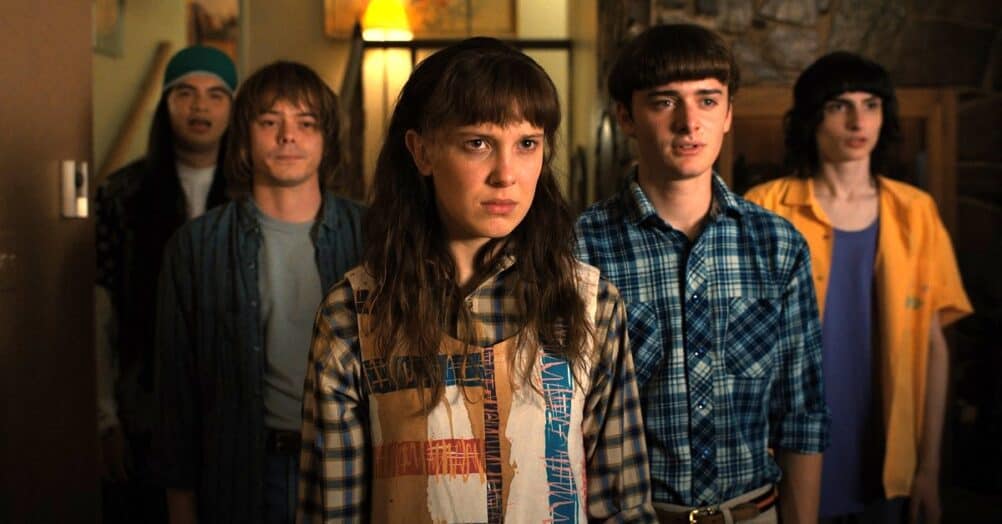Last Updated on July 30, 2021

We all have certain movies we love. Movies we respect without question because of either tradition, childhood love, or because they’ve always been classics. However, as time keeps ticking, do those classics still hold up? Do they remain must see? So…the point of this column is to determine how a film holds up for a modern horror audience, to see if it stands the Test of Time.

DIRECTED BY ISHIRO HONDA
STARRING TAKASHI SHIMURA, MOMOKO KOCHI, AKIRA TAKARADA, AKIHIKO HIRATA
I wonder if Einstein saw GODZILLA when it was released the year before he died. If so, I wonder what the hell he thought about it.
Anyway, as GODZILLA: THE KING OF MONSTERS is set to ravage theaters this Friday, we couldn’t think of a better opportunity to see how the original Japanese classic directed by Ishiro Honda is faring these days. After all, the original not only turns 65 this year, but 2019 also marks the 15th anniversary of the restored version of the film. Now, we all understand how easy it is to mock the sheer camp and kitsch of Godzilla as seen in all of its silly sequels, cheap off-shoots and cartoonish iterations. But let’s not forget about what a massive impact the groundbreaking original had not only in its native Japan – becoming the first of its kind and highest-grossing film in the country up until then, with roughly 11% of the entire population reported to have seen the film during its first theatrical run – but also globally as well. Remember, George Lucas has gone on record citing Honda’s use of miniatures as a major inspiration for the VFX work done on STAR WARS. The lasting legacy of GODZILLA cannot be refuted, but one thing we can debate is the merits of the original as seen through contemporary eyes. It’s with that we invite you to see how well the monster, the myth, the manmade masher, contends with the most undefeated of foes. It’s Godzilla vs. Time yo!

THE STORY: Widely considered to be a Japanese version of THE BEAST FROM 20,000 FATHOMS released one year prior (causing great ire from that films stop motion guru Ray Harryhausen), the name Godzilla is actually derived from a Japanese portmanteau, as it combines the name for gorilla (gorira) and the name for whale (kujira) to form Gojira, or Godzilla. Originally, the design of the monster was supposed to be a mutated hybrid of a gorilla-whale per its namesake, but as we’ll touch on below, was evolved over time by Toho Film. Producer Tomoyuki Tanaka got the idea for the story while returning from Indonesia, when he peered down into the sea and wondered what resided below the surface. Tanaka hired Shigeru Kayama to flesh out the story, who in turned hired Honda and Takeo Murata to pen the screenplay.
As for the actual plot points, the story kicks off when 17 shipping vessels are suddenly blown up and sunken near Odo Island off the coast of Japan. Professor Yamane (Takashi Shimura), his daughter Emiko (Momoko Kochi) and Marine soldier Hideto Ogata (Akira Takarada) head to the island to investigate. Amid the destruction, they catch sight of a gargantuan monster from that rises from the sea and marauds his way onto land, razing every damn object in its path. The monster is soon dubbed Godzilla, though to be the result of American nuclear test bombing gone horrible awry, and a plan must be concocted to dispatch the enormous bastard. Emiko reaches out to her boyfriend, the eye-patched Dr. Serizawa (Akihiko Hirata), whose research on the properties of oxygen end up playing a vital role in their survival. However, Serizawa makes Emiko promise not to expose his creation of the Oxygen Destroyer, as he’s sure the army will confiscate it and use it for their own power-hungry purposes. Alas, Emiko makes the bold choice to save her country by betraying Serizawa and exposing his lethal weapon to her lover, Ogata. As Godzilla trounces across the city leaving a massive wake of destruction in his path, the Japanese officials must make a daring underwater search-and-destroy mission. By now, you know the ending!

WHAT HOLDS-UP: It’s really easy to mock any movie made in 1954 for the ways in which it does NOT hold up by contemporary standards, but GODZILLA is such a landmark achievement in the history of cinema that it sort of defies the rules. That’s not to say the entire film holds up, but to our eyes, far more aspects of the film do stand tall and sturdy than those that don’t. One must start with the brilliant concept that works on the surface level as an entertaining monster-movie, but also makes a profound metaphorical social statement on the horrors of atomic war. This cannot be overstated. While BEAST FROM 20,000 FATHOMS took a similar allegorical approach, remember, GODZILLA is told from the perspective of the one nation in history to actually suffer widespread nuclear devastation via the U.S. bombings of Hiroshima and Nagasaki. Therefore, their point of view is much more founded, salient, honest, and downright emotional.
In fact, so brilliant is the grand allegory of nuclear war leading to mutated monstrosity and war-torn consequences that I’d argue that, without GODZILLA, there would be no red-scare metaphor in INVASION OF THE BODY SNATCHERS, released just two years later in 1956. After all, GODZILLA wasn’t just a massive hit domestically, it made such major waves internationally as well that it demanded Hollywood take notice. And as we’ll delve into deeper below, the metaphor also extends to paint Godzilla as not just a black-and-white villain, but a grey-area victim of sorts who conjures a good amount of sympathy in the end. GODZILLA doesn’t just stand for the H-Bomb, it also stands for those scorched by it.

Of course, the design of the monster itself is one of the movies undoubted lasting legacies. While the design was originally meant to mirror the monster’s namesake – a giant gorilla-whale – Honda and his production team opted to make a unique hybrid of a T-Rex dinosaur, a plated Stegosaurus, and the Iguanodon as the model for Godzilla. It’s safe to say the image of the wholly unique-looking monster that has become a ubiquitous pop-culture staple. Outside of a few silly close-ups of the Godzilla’s eyeballs, the overall design of the monster is still effective today. The way in which actor Haruo Nakajima lumbers around in that ungodly sweltering, 6’5’’ 250 lb suit is still quite alarming, namely in the way it towers over everything in the city.
To wit, the sets, size, scale and scope of the entire production is one of the things that not only holds up well today, but actually looks superior to GODZILLA’s supposed inspiration, BEAST FROM 20,000 FATHOMS. The use of miniature sets beneath the 6.5 foot monster suit effectively gives the allusion that a mega-monster is really marauding through the city. Such careful planning was made in this regard, that the entire film was storyboarded beforehand, marking the first time that has ever happened on a Japanese film production. Even more impressive is how much money Toho spent on realizing such credible set-pieces and FX-drive action sequences. Believe it or not, GODZILLA was made for roughly $175,000, which equates to about $1.6 million in 2019. While it was the most expensive movie ever made in Japan at the time, a million and a half today would likely pay for one episode of the terrible Netflix shows y’all enjoy. Talk about stretching the dollar!

Revisiting the film again this week, I was surprised to notice just how fast-moving the rhythm and pacing of the film is. Seriously, I had to check to see if the frame rate of the version I was watching was sped up at all. The movie is that up-tempo. It goes without saying that this defies the trend of most movies made in 1954, which often unspool slower than mother*cking molasses. At 96 minutes, GODZILLA starts fast and stays the course with a rip-roaring pace that last all the way until the incendiary showdown at the end. This obviously keeps the movie eminently entertaining, which is one of the major reasons why it’s held up so well over the past 65 years.
Speaking of the epic conclusion of the film, very little about how it is constructed has lost its surprising emotionality. By the time our leads make their way underwater to defeat Godzilla, an oddly unexpected sense of sympathy is felt for the beast. Part of it has to do with the somber score of the scene by Akira Ifukube, sure, but it also has to do with the victimized nature of Godzilla to begin with. Almost akin to Frankenstein’s monster, Godzilla is not responsible for his own creation. He is the manmade byproduct of weapons of war gone heinously awry. Godzilla isn’t aware of his actions, he’s only acting on instinct. The aesthetic design of the monster – with a hard, scaly surface – combined with the way he lumbers around aimlessly and bewildered, is said to be modeled after they way in which WWII burn victims stumbled and stammered around in the PTSD symptoms brought about by such horrific scenarios. Watch it again and you might be surprised to see your heart go out to Godzilla in the end. Of course, the lasting legacy of GODZILLA is perhaps its biggest coup in the defeat of time so far. What else to say, GODZILLA has inspired 30 sequels over the past 65 years.

WHAT BLOWS NOW: We won’t belabor this one too much, but the trailblazing special and visual FX work in GODZILLA – that was nominated for Japanese Academy Award at the time – simply does not hold up very well by today’s technologically advanced filmmaking standards. Stop. They just don’t. Yes, they were eye-popping and jaw-dropping at the time (reportedly), but come on, the technology was so rudimentary in 1954 that it’s impossible for such FX to compare with today’s state of the art digitization. One could also lament how many lame ass sequels and imitative offshoots the film spawned since its release, but most of all, it’s the nascent SFX and VFX work that betrays GODZILLA’s age.
THE VERDICT: More than just a visceral monster movie, it’s the metaphorical heft of GODZILLA that has kept it in our collective consciousness for the past 65 years. And rightly so. In addition to the brilliantly perceived cautionary allegory, the things that keep GODZILLA so well maintained include an inspired monster design, a high-flying tempo, great sense of size and scope, a stunningly emotional ending, and its 30-sequel legacy. Combine these ingredients and you have a permanent mainstay of moviegoing pop-culture. Now let’s hope THE KING OF MONSTERS lives up to GODZILLA’s reputation!





















Follow the JOBLO MOVIE NETWORK
Follow us on YOUTUBE
Follow ARROW IN THE HEAD
Follow AITH on YOUTUBE